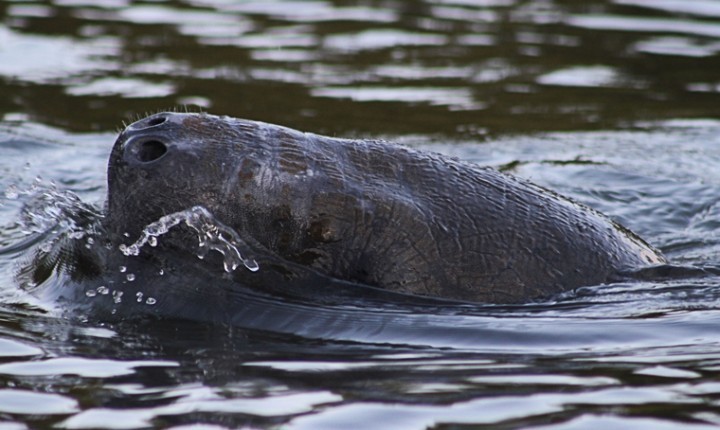
INDIAN RIVER COUNTY — A mysterious and rapidly accelerating die-off of manatees in the Indian River Lagoon seems to be the latest consequence of devastating algae blooms in 2011 and 2012 that killed a majority of seagrass in the estuary.
Troy Rice, director of the Indian River Lagoon National Estuary Program, said last week that 55 manatees have been found dead from shock and drowning in the estuary since July, with the majority of them dying in the past six weeks.
Several days later, the online publication Environmental Protection reported the number of deaths has reached 80.
Seagrass is the primary diet of West Indian manatees, which typically weigh 1,000 pounds or more at maturity and are capable of complex learning and long-term memory, similar to bottlenose dolphins.
With seagrass gone, the manatees have begun eating seaweed in an attempt to survive and that seems to be what is killing them, though it is not clear why.
“We suspect the deaths are related to dietary change due to reduced seagrass availability,” said Florida Fish and Wildlife Conservation Commission spokesman Kevin Baxter. “Dead animals we have autopsied are full of macro-algae, which is seaweed.”
Environmental Protection reports the manatees have been eating gracilaria, a red-colored seaweed, and Rice says the animals have purple stains inside and around their mouths.
Macro-algae is not normally toxic and Fish and Wildlife scientists have not figured out exactly how it is killing the manatees, if that is actually what is killing them.
“We have tested the animals, the macro-algae and the water, looking for known toxins and so far we haven’t found anything that explains the way they are dying,” Baxter said, though it is clear from the fact they are drowning that something is interfering with the marine mammals’ ability to surface and breathe.
When a call comes in to Fish and Wildlife about a dead manatee, a team is dispatched to find the carcass and bring it to a laboratory for examination.
The agency is looking for viruses, bacteria and other signs of disease as well as toxins.
Current problems in the estuary, which may amount to the beginning of ecosystem collapse with a rapid decline in biodiversity, started in 2011 with what is now called the “superbloom,” a deadly florescence of nutrient-fed algae that decimated much of the lagoon.
According to a study group formed by St. Johns River Water Management, “from early spring through late fall of 2011, a massive bloom of phytoplankton and loss of seagrass occurred throughout most of the Indian River Lagoon system, extending from the southern Mosquito Lagoon to just north of the Fort Pierce Inlet. This bloom and seagrass decline far exceeded any past events remembered or documented in terms of geographic scale, bloom intensity and duration, and rate and magnitude of seagrass loss.”
Seagrass loss continued in 2012, with a massive brown algae bloom clouding the water in the northern lagoon and a mysterious die-off north of Vero Beach.
“In total, we have lost two-thirds of the seagrass between Vero Beach and the northern end of the Indian River Lagoon,” said St. Johns River Water Management District scientist Lori Morris at a lagoon symposium last month at Harbor Branch Oceanographic Institute. “For some reason, Indian River County was the hardest hit area.”
Other speakers at the symposium reported that chlorophyll, a marker of lagoon distress that indicates excess nutrients, increased 10-fold in some places during the bloom and that more than 2,000 metric tons of sea grass have disappeared in the past two years.
Algae blooms are fed by excess nutrients that come in part from runoff polluted with fertilizer that enters the lagoon during rainstorms and by seepage into ground water.
Algae consume oxygen and make the water murky, cutting off sunlight to seagrass and smothering life in the estuary.
“We have had the greatest loss of biomass ever, and we are not seeing recovery,” said Robert Chamberlain, another St. Johns research scientist.
By last summer, game fish had largely disappeared north of the Barber Bridge, according to scientists and fishermen.
“We caught an abundance of fish last year in that area. You can’t catch a single fish there now, other than some migratory species like ladyfish and jack that are passing through,” Captain Paul Dritenbass said in August. “There are no spotted trout, no redfish, no resident fin fish of any kind. It is a wasteland out there.”
“Seagrass beds are where most of the biodiversity is,” Grant Gilmore, Ph.D., senior scientist with Estuarine, Coastal and Ocean Science, Inc., said at the same time. “If you lose the seagrass, you lose most of the species in the lagoon. The pigfish depend on seagrass. No seagrass, no pig fish. Pig fish is the favorite food of sea trout. And sea trout are the favorite food of bottlenose dolphins. If we lose the seagrass permanently, we lose our beloved dolphins and manatees. This is a crisis that should concern everyone.”
Manatees are also dying in large numbers on the west coast of Florida where red tide has killed more than 200 this year.



